In 1997, I trekked from Lukla to Everest Base Camp. Those three weeks changed my life forever. This first week of April 2012, thousands are doing the same journey and, I expect, with many experiencing the same results.
We now have most of the Everest south teams en-route to Base Camp. Himex just reported as massive group of 55 (!) climbers, trekkers and Sherpas as they are preparing climbs on three different mountains this season: Everest (24), Lhotse (7) and Nutpse (5). Nutpse is the most visible peak as you approach base camp situated on the Southwest corner of the Western Cwm. It is rarely climbed so it will be fun watching a team of four women attempt it this year.
The Khumbu continues to be the hotbed of activity with Bandar once again keeping us updated on the eating habits:
The local bakeries along the trek to basecamp are famous and rightfully so. If there is one standout so far, it is definitely the one at tangboche. The selection would be adequate for a bakery in the middle of a large metropolitan city and the group favorites were the apple crumble cake, dutch apple pie and apple strudel.I ate all three and all three were delicious.
There are undoubtedly many beautiful places on earth and many cultures that leave a lasting impact on their visitors. The Solo-Khumbu area of Nepal is one of these.
Located south of Mt. Everest following the Dudh Kosi River, this is an area that remains simple yet complex as it struggles with the double-edge sword of tourism.
It is the region that the Sherpa people of Tibet migrated to over centuries and today represent the largest concentration of those families. Many work in the climbing, trekking and tourism industries bringing a better standard of life for their families.
Beyond the metrics, it was the people and the environment that left a lasting impression on me in 1996 and again last year, 2011; my sixth trek through the Khumbu.
A Simple Smile
The trek starts in Lukla, following the Dudh Kosi River towards Namche. This first section reveals a hint of what is to come- wide vistas of pine trees set against the snow covered foothills of the Himalaya. You pass through multiple villages located outside the Sagarmatha National Park. Kids walk the trails in uniforms going to school eager to say hello and practice their English or just to offer a smile.
It doesn’t take long to let the simplicity of the area sink in. No cars, motorcycles and even bicycles – in fact no wheels! You share the trail with fellow trekkers and climbers but also with the human and animal labor that brings raw materials to the upper villages.
It is not surprising to see a young man with several doors strapped to his back, walking in sandals, smoking along the way – pass you.
A train of Zos, the cross between a yak and a cow, are loaded with barrels or duffles on their way to base camp. An occasional horse goes by but only a couple as they don’t like this rarified air. Unlike Argentina, mules are rare.
Daylight in the Dark
Once above Namche, the trails takes a dip to the river and gains again to the village of Tengboche and it’s monastery. This milestone in the trek allows for insight into the Buddhist culture. Less than 100 monks now call this home, dramatically down from previous years. If your timing is correct, you can join them for daily prayers.
Entering the dark monastery, you take your shoes off outside the door as you enter and turn right following the well worn wood floor. The huge alter occupies your view and a giant Buddha takes up the back of the space. Several rows of padded benches fill the center and guests are asked to sit quietly against the side walls. It is quiet. It s cold. A monk smiles as he offers you a warm rug to sit upon.
Against this serenity, the monks gather quickly, with purpose, to perform their daily ritual. Each one takes their spot, there is only the occasional word. Without notice, the chanting begins and in perfect harmony, all the voices join.
In spite of the monotone first impression, you soon realize they are speaking individual words in rapid succession – almost without breathing. The sounds lulls you into a place of peacefulness, solitude. In your own thoughts, you take the moment in until a young monk bangs the drums followed by a clash of the cymbals. With eyes now open, you look around and for the first time notice the dust suspended in the sun’s rays as they pass through the smoked windows.
Stepping out of the Monastery, another feast. Ama Dablam stands to your right – majestic, formidable, daring; and then there is Everest off to the north – waiting.
A Moment of Reality
Further up the Khumbu, another milestone. Almost every Everest climber and many trekkers will spend an hour with Lama Geshe. The elderly Lama now mended from serious illness two years ago welcomes guests in his modest home along with his wife and sometimes his daughter. The ceremony takes place where he prays for permission for you to climb and for your safety. This experience warrants a separate post, no, a book. His presence is deep, it is meaningful. He is real in a world of reality.
Leaving the trees behind, the trail becomes more rock than dirt. The yaks now occupy the open spaces. Huge and gentle, these beast meander along carrying their loads. Mostly blue barrels and white rice bags filled with all the gear climbers think is necessary. Occasionally there will be the yak annoyed by a table, or a satellite dish lashed to his carpet covered back. Surprises are common up here.
The Upper Reaches
More up and down, more views of “hills” higher than the highest back home. The air is clear, the breeze talks quietly to open ears telling of the trials this area has seen. The plumes revel the dangers that await. Sense are teased, minds are opened.
Between Periche and Lobuche, another moment to pause. Atop a ridge stand 50 stone chortens honoring mostly the Sherpa who have died on Everest over the decades.
I make a point to walk by each one, ignoring the impact on schedule as if there is one. I try to read the names; most are worn down by years of wind, rain and snow. I touch each one wondering what happened. Closing my eyes, I can see them high on the Hill, most are still there. Their sacrifices for our goals. A high price.
The altitude is now serious, almost 17,000 feet or 5200 meters. Even a quick move brings a heavy breath … and a smile from a nearby Sherpa. The air has a chill; the wind bites. You know your destination is near.
Knowing as a climber you will be going much higher, you take a day hike to a nearby ridge. Each step requires conviction. You begin to learn that climbing in the Himalaya is as much about patience as it is strength. Atop the ridge, the grass calls out as the sun warms the hillside. You lay down gently giving yourself permission to be consumed by the surroundings. A cloud goes by and you hear the chatter of teammates. You let your body do what it needs to do.
Shelter and More
The refuge of a teahouse is welcome. Pulling open the wooden door, you enter a single large room. Padded benches line the perimeter, simple tables stand ready. Every one has the same glass enclosed counter. The owner smiles as you approach; glad to sell you bottled water, a snickers bar or even time on the solar battery to recharge your phone.
The menu is the same – fried rice, eggs, dal baht or soup. It really doesn’t matter. Served on a single tin plate you eat slowly taking it all in. Fellow trekkers and climbers from around the globe create a modern day Tower of Babel.
The Beginning of a Journey
Arriving at the last village of Gorak Shep, Everest Base Camp is only a few hours away – the next day. You can see Kala Patar, a tall rounded hill with a sharp top nearby. The 18,192’ summit will set personal records for many.
But they climb not for records but for the view. Everest is exposed to anyone willing to look. This early in the season the jet stream still hovers dominantly over the roof of the world. The plume wisps wildly for miles to the east. You simply stare.
Looking back down valley you can almost see where you started. Your journey is before you – in so many ways.
The Khumbu can change your life. Let it.
Climb On!
Alan
Memories are Everything

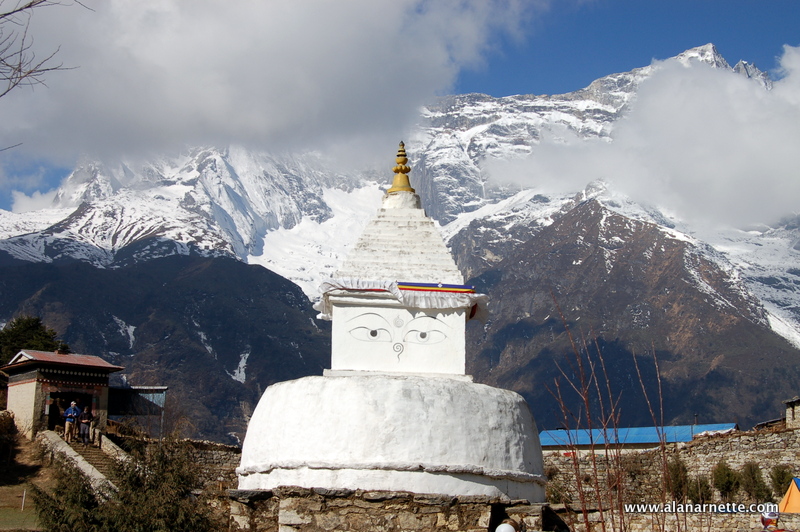
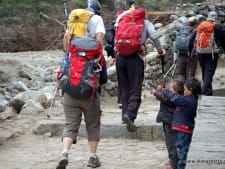
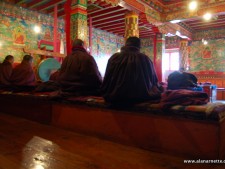
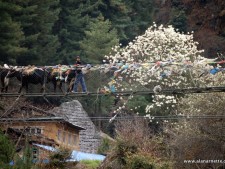
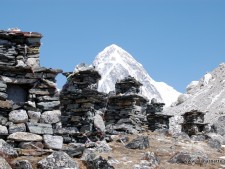
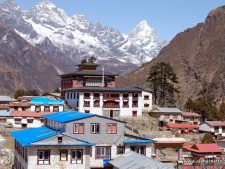
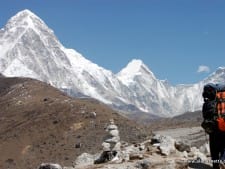

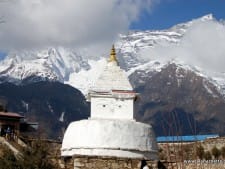

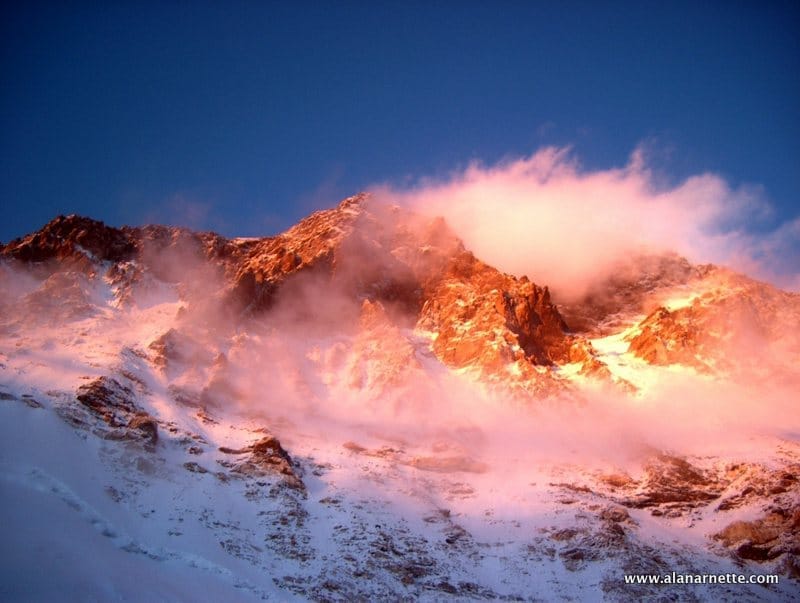
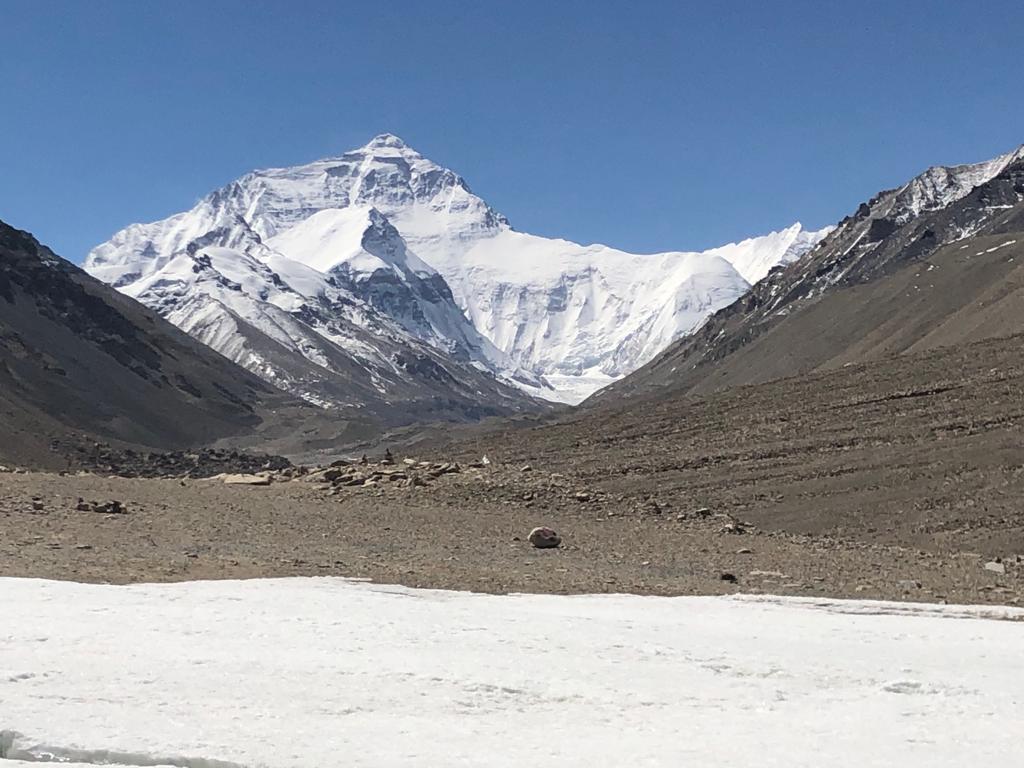
11 thoughts on “Everest 2012: Trekking the Khumbu”
Thanks all, I am glad you enjoyed my description of this magical place. Ellen, you need to be good health and able to walk a few miles each day at ever increasing altitudes for this trek- no mountain climbing 🙂
My dream is to go there! Thanks for sharing the sights, sounds, & spirituality with us. What kind of physical shape do you need to be in to go on an organized trek in the area?
Wow Alan! So beautifully written!
“Let it” – Well , – it did! In more than one way!
Been there in 2006 and in 2010 to Mera Peak.
After reading your blog and forwarded to loved ones, I realised that we need to go to the Khumbu again! Why, I don’t fully understand, but I keep on longing to be there again.
The wonderful people of Nepal and the majestic mountains sure touch ones soul.
Thank you!
Inamarie Greyson – South Africa
“Let it.” Perfect. I envision doingthis trek one day. Letting it take me. Thank you, Alan.
Alan, This is so beautifully written. You make us all want to be there again, or experience it for the first time. Hope to bring a group back to base next year and relive these memories. Thanks for your inspiration.
You mentioned “In 1997, I trekked from Lukla to Everest Base Camp. Those three weeks changed my life forever”.
You should write a post (after you trip) about this experience. Why It was so life-changing!
Regards from Brazil!
Alan, your blog today was quite beautiful and brought a tear to my eye.If I closed my eyes I could actually feel I was lying on the grass with all the sounds and smells around me.Sadly after four failed spinal ops.my outdoor roaming is at an end but I have four outward bound children and one who climbs.Last year our British climber Alan Hinkes paid me a visit which was brilliant.I am following four Briitish expeditions this season and together with your wonderful web I am finding that my afternoons and early evenings are quite fullfilling. At the end of the season last year it was almost
Ike a bereavement and I missed all the blogs so much. Thank you once again
I echo Maury’s sentiment!
I was told before going to Nepal that my life would not be the same afterwards. I did not understand why back then. However, now I understand. The people and sights of Nepal are forever etched in my heart.
The people and country of Nepal is forever etched in my heart. I long to go back very soon.
Wow, beautifully written, Alan. Do you lead treks to base camp? I want to go sometime. It sounds amazing.
Comments are closed.